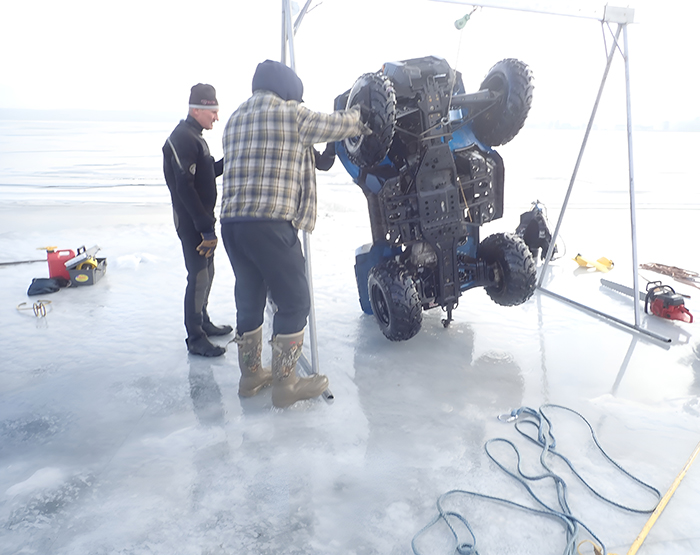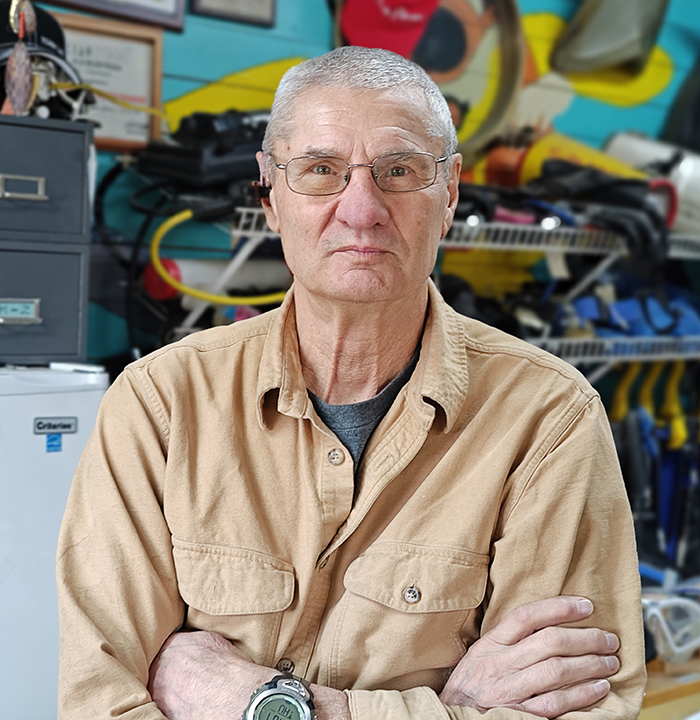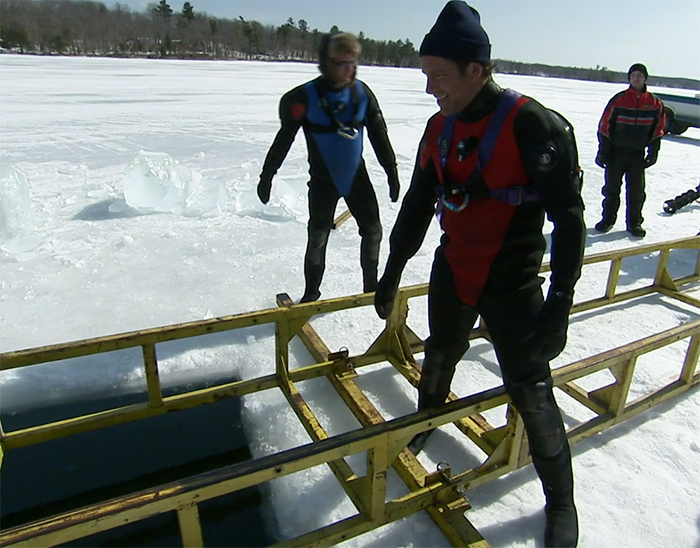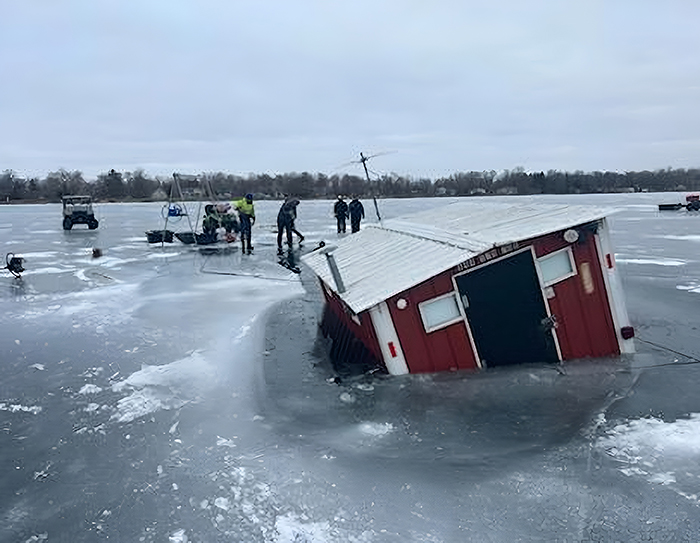Tri-State Diving delivers during busy season
News | Published on January 23, 2024 at 3:01pm EST | Author: frazeevergas
0DL-based company led by legendary Gary Thompson

By Robert Williams
Editor
Gary Thompson, owner of Tri-State Diving, has seen plenty of sketchy years when it comes to ice, but nothing like the early season last year in December stretching into January. He and his team have been busy retrieving vehicles and fish houses at a rate from lakes around the region like they have never seen before. ¶ “This is the worst because of the rain we got,” Thompson said in an early January interview. “We still had the thickness of ice, but it didn’t have the strength anymore.” ¶ The warmth of this winter seemingly made up for a rare quiet season in 2022-23. The dive team had only four calls all of last winter, which was unusual. ¶ “Normally, we average one a week throughout the year,” said Thompson. “Sometimes we’ll have three in a row and then nothing for a couple weeks, but over the winter we average one a week whenever ice comes on until ice goes off.”

Last year was so mild, Thompson easily listed off the four jobs: a snowmobile on Otter Tail Lake; a tractor in the cities, a side-by-side near Garrison, North Dakota and another at the end of the season on Long Lake.
This past December, Thompson and his team did three jobs in one day and had 13 calls in a three-day span during the Christmas holiday.
“We’re ahead of schedule,” he laughed. “You’re taking a gamble every time you go out on the ice. Even two-feet, you’re taking a gamble. You can have two-feet here and over there an inch.”
Tri-State Diving has become an automatic call for retrieval services in Minnesota and both North and South Dakota. Tri-State means exactly as it sounds. From Lake of the Woods and the Rainy River to western area of both Dakotas.
Thompson started diving in 1967 and has been thorough about it from the very beginning. He owns volumes of dive charts and has tracked every dive he has ever done.

“Three are over 4,000 dives there,” he said.
Thompson was inspired at a young age by the first outdoor syndicated television show “Sea Hunt” that aired in syndication from 1958 to 1961 and was popular for decades afterwards. The series starred Lloyd Bridges as former Navy diver Mike Nelson.
“I was at a conference once and we had to tell everyone how we got into the profession we’re in and I said Mike Nelson and about three of them knew right off the bat. The rest of them had no clue and I had to explain it,” said Thompson.
Thompson’s family owned a cabin on a lake east of Mahnomen when he was growing up and he put the lake to good use, but unlike other kids.

“Everybody else would be out water skiing or swimming and I was snorkeling every time I got a chance,” he said.
With more than a half-century of diving experience, Thompson has seen a massive change in equipment from his early years to today.
“There’s no comparison. It’s much safer. We didn’t even have a pressure gauge to see how much air we had left in our tanks,” he said.
Thompson graduated from Ada high school in 1967 and by 1969, Tri-State was formed with a friend from Fargo and initial business revolved around body recovery as only area emergency services were doing the job at the time.
“We did that for years,” he said.
Thompson worked in law enforcement and trained many officers in diving and rescue operations. He kept the Tri-State name when he took over the business solely and opened up his shop at his home after finishing his law enforcement career.
His list of jobs is endless from commercial and salvage diving to underwater cutting torch work, stump and piling cutting for wood.
He removed 158 bridge pilings from the old Heartland Trail bridges near Park Rapids.
He does hydrostatic testing on tanks, service work on regulators and a host of dive training and lifeguard classes.
“My whole career has been around water,” he said.
He started early as a lifeguard at the Ada swimming pool and became the Aquatic Director at the Fargo YMCA. He attended the National Aquatic School and became an instructor capable of training lifeguards and swimming teachers and he continues to certify lifeguards around the state and completes compliance checks on pools. His classes include training law enforcement dive team members.
Thompson is 75, something he describes as recently celebrating the 25th anniversary of his 50th birthday. He could pass for 50, easily, but has pondered retirement a ways up the road. The problem with selling a business like his is he has built it on a lifetime of learning.
“If I ever sell the place out, the next guy is going to have to go through at least one or two years of training,” he said. “You can be a scuba instructor, but you can’t make it on just classes in this part of the world. That’s why most shops don’t make it around here.”
Thompson is also an innovator and international expert at his craft. He owns the patent on his SUVE, an apparatus he designed known as the submerged underwater vehicle extractor.
After watching other people take days to remove a vehicle from the water, he set about creating a tool to cut the time down.
“There’s got to be an easier way,” he said.
Thompson is frequently requested for appearances on the Weather Channel and made international news in 2002 when his team helped remove a dozen trailers from Big Detroit Lake that sank into the water prior to a snowmobile race.
In 2008, he was featured on Mike Rowe’s Discovery Channel show “Dirty Jobs.” The episode is available online at go.discovery.com – season three, episode 11. Rowe helped the Tri-State team utilize the SUVE and made the top five episodes in the show’s history for innovative design and was rated in the top 25 of all the episodes over 11 seasons. There were 30 hours of tape shot for the 15 minute-episode.
“They did a pretty good job at it,” said Thompson.
Thompson and his team take care when removing vehicles and fish houses making sure to do so without further damaging the product.
“We pride ourselves on not doing that, whether it’s a pickup or whatever,” he said.
Even to vehicles that are destined for the scrap yard after recovery.
“Whatever insurance company gets it; it goes someplace and they’ll get money for it because it’s in good shape,” he said. “That’s why they hire me because they’re going to get something out of it.”
Thompson noted he’s seen other recoveries where a vehicle was crushed or completely bent in half.
Each job has its own peculiar set of circumstances from ATVs and tractors on the bottom of a lake to fish houses sitting one-third underwater. One house that was retrieved near Motley, has to wait in the water until ice reformed. The owner could get to it by kayak but the team needed more ice to get the house out.
“It was bobbin’ like a cork out there,” said Thompson.
Tri-State Diving has gained a large, international audience that watches recovery jobs on the company’s Facebook page.
This winter, fans saw a skid house on Rush Lake where the team cut around the house to get it broken loose from the ice. From there, sometimes the house can be walked back to shore or pulled with an ATV and sometimes winched up and out of the lake and onto the ice surface.
A call for an ATV, small fish house or snowmobile typically requires a team of three people.
Larger items like side-by-sides or tractors tend to require up to five people.
Occasionally, ATVs will become submerged and will drift away from the original hole.
An underwater camera with 200-feet of line is used to go down and search and once found the job will definitely require divers.
The most common question for Thompson is about fees and it’s not something that is easily explained with a quick number. All jobs are based on the time it takes and what is being removed or retrieved, along with drive time and dive depth that includes a charge per atmosphere down.
The deepest dive Thompson has done was 126-feet in nearby Rose Lake.
Thompson was also featured in the 2010 documentary “Timber Dead and Down,” a film that portrayed a variety of perspectives on the Timber industry, specific to the Northern regions of Minnesota where the three “biomes” merge, by Executive Producer, Jeff Schlossman.
Thompson’s shop is filled with a vast collection of finds from his 4,000 dives, including a log branding tool that was specifically used on logs traveling down the Otter Tail River to the old Frazee mill.
Thompson is also active in area trails working with his ATV club and the Wolf Lake Snowmobile Club on trail maintenance near Wolf Lake and looking to join trails for ATVs and sleds with a shared trailhead, along with another planned ATV trail near Ice Cracking Lodge.

